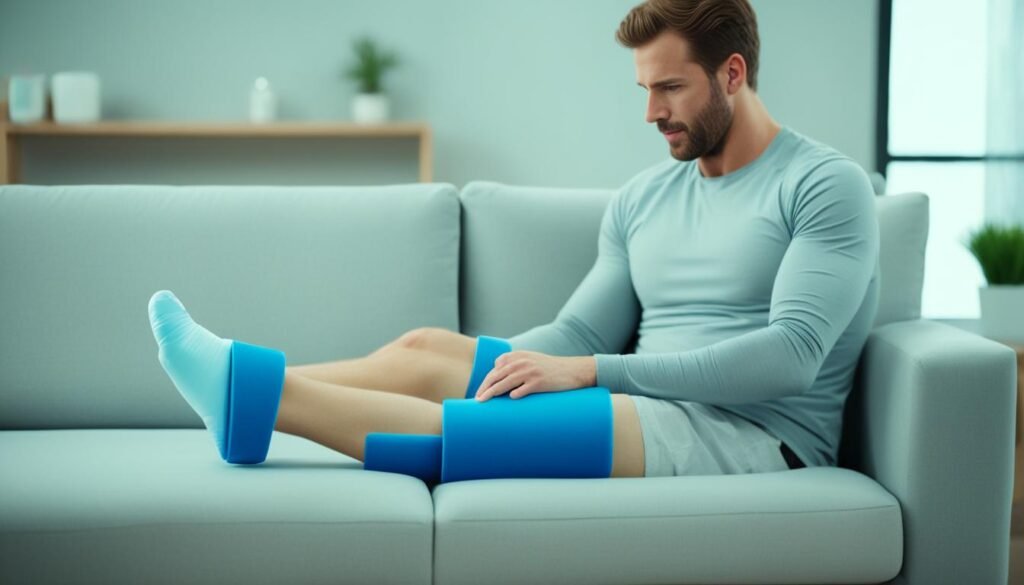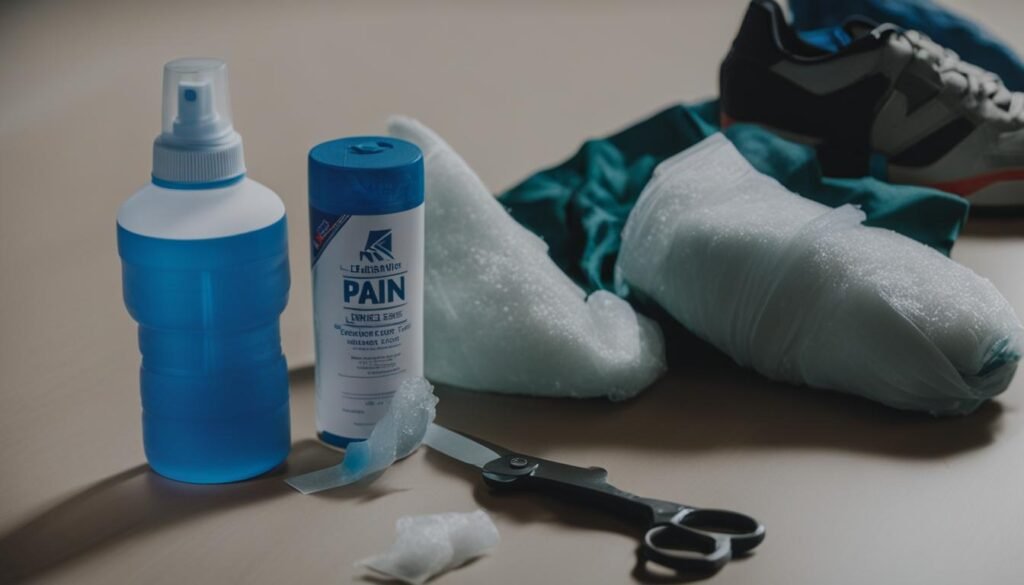When it comes to sprains, immediate first aid is crucial in reducing pain and swelling. Whether it’s a sprained ankle, knee, or wrist, knowing how to provide quick relief can make a significant difference in your recovery. In this article, I will guide you through the essential steps of sprain first aid, so you can effectively manage your symptoms and promote healing.
Sprains occur when a ligament is stretched too far or torn. Common symptoms include swelling, pain, and bruising. Resting the injured limb, icing the area, compressing it, and elevating it (R.I.C.E) are the initial steps for first aid. To further alleviate discomfort, you may also consider over-the-counter pain relievers like ibuprofen or acetaminophen.
Key Takeaways:
- Immediate first aid for sprains can help reduce pain and swelling.
- The R.I.C.E method (rest, ice, compression, elevation) is the initial treatment for sprains.
- Pain relievers like ibuprofen or acetaminophen can provide additional relief.
- Seek medical attention if you experience severe pain, inability to bear weight, or signs of infection.
- Prevention and rehabilitation play vital roles in long-term sprain care.
Understanding Sprains and Ligament Injuries
In order to effectively address and treat sprains, it is essential to have a clear understanding of the role of ligaments in our bodies. Ligaments are resilient bands of fibrous tissue that connect bones together, providing stability and support to our joints. They are crucial for maintaining proper alignment and preventing excessive movement that can lead to injury. However, when ligaments are subjected to excessive force or sudden twisting motions, they can become stretched beyond their normal capacity, causing sprains.
Sprains occur when ligaments are stretched, and in more severe cases, tear partially or completely. The severity of a sprain is often determined by the extent of ligament damage, which can vary from a mild strain to a complete rupture. The level of pain and swelling experienced is also closely related to the severity of the injury.
The most commonly affected areas for sprains are the ankles, knees, and wrists. These joints are vulnerable to sprains due to their complex structure and the frequency at which they are used during physical activities. Understanding the specific vulnerabilities of these areas can help individuals take appropriate precautions and minimize the risk of sprains.
Treating Minor Sprains at Home
When it comes to minor sprains, it’s comforting to know that self-care can be done within the comforts of your own home. By following a simple yet effective method known as R.I.C.E, you can alleviate pain, reduce swelling, and promote the healing process. Let’s delve into the details of this method and how you can apply it for treating sprains at home.
R.I.C.E Method: Self-Care for Sprained Injuries
The R.I.C.E method stands for Rest, Ice, Compression, and Elevation. These four principles form the foundation of treating minor sprains and can help you recover more quickly.
- Rest: Begin by resting the injured limb or area. Avoid putting weight or strain on the sprained joint or muscle. Rest allows the body to naturally heal and prevents further damage.
- Ice: Applying ice to the affected area helps reduce swelling and inflammation. Wrap an ice pack or a bag of frozen vegetables in a thin towel and place it on the sprain for approximately 15-20 minutes, several times a day. Remember to avoid direct contact between ice and skin to prevent ice burns.
- Compression: Compressing the sprained area with an elastic bandage or wrap provides support and helps minimize swelling. It’s important not to wrap too tightly, as this can restrict blood flow. Adjust the compression bandage to ensure proper fit and comfort.
- Elevation: Elevating the sprained limb above heart level can help reduce swelling and promote fluid drainage. Prop up the injured area with pillows or cushions whenever possible.
This combination of rest, ice, compression, and elevation not only aids in pain management but also facilitates the body’s natural healing process. It’s important to note that self-care measures may vary depending on the severity of the sprain. If you experience severe pain, persistent swelling, or limited mobility, it’s advisable to seek medical attention for a comprehensive evaluation.
| Treating Minor Sprains at Home – R.I.C.E Method | Benefits |
|---|---|
| Rest the injured limb | Prevents further damage and allows the body to heal |
| Apply ice to reduce swelling | Reduces inflammation and pain |
| Use compression wraps | Provides support and minimizes swelling |
| Elevate the limb | Reduces swelling and promotes fluid drainage |
Remember, while many minor sprains can be effectively managed at home, it’s crucial to listen to your body and seek professional medical advice if symptoms worsen or persist. In the next section, we will explore the immediate steps to take for first aid after a sprain.
Immediate Steps for First Aid
After a sprain, it’s crucial to take immediate action to minimize pain and promote healing. By following these first aid steps, you can provide initial care for a minor sprain:
Rest and Avoid Weight-bearing Activities
First and foremost, it’s important to rest the injured limb and avoid any weight-bearing activities. This allows the affected ligaments and tissues to recover and reduces the risk of further damage.
Apply Ice to Reduce Inflammation
Ice application is an effective way to reduce inflammation and swelling associated with a sprain. Simply place an ice pack or a bag of frozen vegetables wrapped in a thin cloth on the injured area for about 15-20 minutes, several times a day.
Compress the Area with an Elastic Wrap or Bandage
To minimize swelling and provide support to the injured limb, it’s recommended to compress the area using an elastic wrap or bandage. Make sure not to wrap it too tightly, as it may restrict blood flow.
Elevate the Limb above the Heart Level
Elevating the injured limb above the heart level helps reduce swelling by promoting proper blood circulation. Prop the limb up on a pillow or cushion to achieve the desired elevation.

Remember, these immediate first aid steps are intended for minor sprains. If you are experiencing severe pain, unable to move the limb, or suspect a more significant injury, it is important to seek medical attention for further evaluation and treatment.
Long-Term Recovery and Rehabilitation
Sprains can vary in their healing time, ranging from days to months depending on the severity. Once the initial pain and swelling subside, it is important to focus on long-term recovery and rehabilitation to regain strength and stability in the injured area.
Gradual and gentle movement of the injured area is recommended as part of the recovery process. This helps improve blood circulation, reduce stiffness, and prevent muscle weakness. It is crucial to avoid putting excessive strain on the injured ligaments during this phase.
One of the key aspects of sprain recovery is engaging in proper strengthening exercises. These exercises are typically guided by a physical therapist or sports medicine professional who will tailor the program based on the individual’s specific needs and the area of the body that has been sprained.
The strengthening exercises are designed to gradually rebuild muscle strength and restore stability in the injured area. They may include a combination of stretching, resistance training, and balance exercises. The goal is to enhance the overall function and mobility of the ligaments and surrounding muscles.
It is essential to prioritize adequate healing before returning to sports or other strenuous activities. Rushing the recovery process can lead to reinjury or further damage. Gradually increasing the intensity and duration of physical activity under the guidance of a healthcare professional ensures a safe and effective transition back to normal activity levels.
Remember, every sprain is unique, and the recovery time may vary. It is important to listen to your body, follow the advice of your healthcare professional, and be patient throughout the recovery process.
When to Seek Medical Help
While most minor sprains can be treated at home, there are situations where seeking medical attention is necessary. It is important to recognize when a sprain doesn’t get better or when it may require more than simple self-care.
If you are experiencing severe pain that persists or worsens over time, it indicates a potentially severe sprain. In such cases, it is recommended to consult a healthcare professional for an accurate diagnosis and appropriate treatment.
In addition, certain symptoms may indicate the need for medical help:
- Unable to put weight on the injured limb: If you find it difficult or impossible to bear weight on the affected limb, it may be a sign of a severe sprain requiring medical attention.
- Numbness or instability: Experiencing numbness, tingling, or a feeling of instability in the injured area may indicate nerve damage or a more serious underlying condition.
- Color changes or streaks indicating infection: If you notice unusual color changes, such as redness, warmth, or streaks around the sprained area, it could be a sign of infection and should be evaluated by a healthcare professional.
“It is important to recognize the signs that require medical intervention in order to prevent further complications and ensure proper healing.” – Dr. Jane Sullivan, Orthopedic Specialist
In cases of severe sprains or reinjury of a previously injured area, seeking medical help is strongly advised to receive appropriate care and guidance for a safe and successful recovery.
| When to Seek Medical Help | Signs and Symptoms |
|---|---|
| Unable to put weight on the injured limb | Difficulty or inability to bear weight on the affected limb |
| Numbness or instability | Numbness, tingling, or feeling of instability in the injured area |
| Color changes or streaks indicating infection | Unusual color changes, redness, warmth, or streaks around the sprained area |
Pain Relief and Medication Options
When it comes to managing pain associated with sprains, over-the-counter pain relievers can be a helpful option. Two commonly used pain relievers for sprain relief are ibuprofen and acetaminophen. These medications have anti-inflammatory properties, which can alleviate discomfort and reduce swelling.
It is important to follow the recommended dosage provided on the packaging or as advised by a healthcare professional. Taking more than the recommended dose can have adverse effects on your health. Always consult a healthcare professional if the pain persists or worsens despite using pain relievers.
Tips for Safe Use of Pain Relievers:
- Read and follow the instructions on the packaging carefully.
- Use the appropriate dosage based on your age and weight.
- Avoid exceeding the maximum daily dose.
- Do not use pain relievers for an extended period without consulting a healthcare professional.
- In case of any side effects or concerns, seek medical advice.
“Pain relievers like ibuprofen and acetaminophen can effectively manage pain associated with sprains. However, it’s important to use them safely and consult a healthcare professional if needed.”
Remember, while pain relievers can provide temporary relief, they should be used in conjunction with other sprain relief remedies and proper first aid measures. If you have any concerns or questions about using pain relievers, reach out to a healthcare professional for guidance.
| Pain Reliever | Common Brand Names | Recommended Dosage |
|---|---|---|
| Ibuprofen | Advil, Motrin | Adults: 200-400mg every 4-6 hours Children: Based on weight and age, consult a pharmacist or healthcare professional |
| Acetaminophen | Tylenol | Adults: 325-650mg every 4-6 hours Children: Based on weight and age, consult a pharmacist or healthcare professional |

Prevention is Key
While it may not always be possible to completely prevent sprains, taking certain precautions can significantly lower the risk. By incorporating these sprain prevention tips into your routine, you can minimize the chances of experiencing a sprain and stay active and injury-free.
1. Warm Up Before Physical Activities
To prepare your body for physical exertion, it’s important to warm up properly. Engage in light aerobic exercises or dynamic stretches to increase blood flow to your muscles and improve joint flexibility. This will help reduce the likelihood of sprains during intense physical activity.
2. Use Proper Footwear
Choose footwear that provides adequate support and cushioning for the activities you engage in. Whether it’s running, playing sports, or hiking, wearing shoes that fit well and offer stability can help prevent ankle and foot sprains. Additionally, consider using orthotics or inserts if you have specific foot conditions that require additional support.
3. Maintain Strength and Flexibility
Strengthening the muscles around your joints and maintaining good flexibility can help prevent sprains. Incorporate exercises that target the muscles supporting the areas most vulnerable to sprains, such as your ankles, knees, and wrists. Performing stretching exercises regularly can also improve joint range of motion, reducing the risk of injury.
4. Be Mindful of Surface Conditions
Pay attention to the surfaces you walk or exercise on, as uneven or slippery surfaces may increase the likelihood of a sprain. Avoid walking or exercising on unstable ground, such as wet grass or icy pavement. Use caution when participating in activities where the surface conditions may be unpredictable, such as hiking or trail running.
By following these sprain prevention tips, you can protect yourself from unnecessary injuries and enjoy a more active and pain-free lifestyle.
| Prevention Tips | Description |
|---|---|
| Warm up before physical activities | Engage in light aerobic exercises or dynamic stretches to increase blood flow and joint flexibility. |
| Use proper footwear | Choose shoes that provide support and cushioning appropriate for your activities. |
| Maintain strength and flexibility | Strengthen muscles around the vulnerable areas and perform regular stretching exercises. |
| Be mindful of surface conditions | Avoid unstable or slippery surfaces that increase the risk of sprains. |
Rehabilitation and Long-Term Care
After the initial treatment and recovery, it is important to focus on rehabilitation and long-term care. Physical therapy exercises can play a crucial role in sprain recovery and preventing future injuries. These exercises should be performed under the guidance of a trained healthcare professional to ensure proper technique and effectiveness.
Physical therapy for sprain recovery typically involves a combination of stretching, strengthening, and functional exercises. These exercises help improve flexibility, build strength, and restore the joint’s range of motion. They also promote overall stability and reduce the risk of reinjury.
Flexibility exercises are designed to improve the range of motion in the injured area. These may include gentle stretches and controlled movements that gradually increase the joint’s flexibility without causing any pain or discomfort. By improving flexibility, the injured ligaments can regain their full function and prevent further sprains.
Strengthening exercises focus on building muscle strength around the injured joint. This helps provide support and stability, reducing the strain on the ligaments. Strengthening exercises may involve the use of resistance bands, weights, or bodyweight exercises that target specific muscle groups. Proper form and technique are crucial to ensure safe and effective strength training.
In addition to flexibility and strengthening exercises, functional exercises are also important for sprain rehabilitation. These exercises aim to improve balance, coordination, and proprioception (the sense of joint position). Functional exercises often mimic daily activities or sports-specific movements, helping individuals regain their ability to perform these tasks confidently and without pain.
It is essential to follow the prescribed exercise regimen from the healthcare professional. Gradually increasing the intensity and difficulty of the exercises in a controlled manner will ensure steady progress and minimize the risk of re-injury. Consistency and patience are key to successful sprain recovery.
Sprain Rehabilitation Exercises: Sample Program
| Exercise | Description |
|---|---|
| Quad Sets | Tighten thigh muscles while sitting with the legs extended. Hold for 5 seconds and repeat for 10 repetitions. |
| Ankle Pumps | Move the ankle up and down while seated. Perform 20 repetitions in each direction. |
| Heel Slides | Slide the heel towards the buttocks while lying on the back. Repeat for 10 repetitions. |
| Wall Pushes | Stand facing a wall with both hands placed on the wall. Gently push against the wall, keeping the injured leg straight. Hold for 5 seconds and repeat for 10 repetitions. |
| Single-Leg Balance | Stand on the injured leg and maintain balance for 30 seconds. Repeat for 3 sets. |
Remember to consult with a healthcare professional or physical therapist for a personalized rehabilitation program tailored to your specific needs and injury severity. Following the recommended exercises and gradually progressing will maximize the chances of a full recovery and reduce the risk of future sprains.
Conclusion
Sprains are common injuries that can be effectively managed with proper first aid. By following the R.I.C.E method (rest, ice, compression, and elevation), individuals can reduce pain and swelling associated with sprains. Seeking medical help when necessary is crucial in cases of severe sprains or when symptoms worsen.
Once the initial healing has taken place, gradually returning to activities and exercises under the guidance of a healthcare professional promotes long-term recovery. It is important to prioritize prevention measures to decrease the risk of future sprains. This includes warming up before physical activities, using appropriate footwear, maintaining strength and flexibility, and being mindful of the surface on which you are walking or exercising.
Continued rehabilitation and self-care play vital roles in the overall recovery process. Physical therapy exercises that focus on strengthening the injured area can help prevent future sprains. It is essential to consult with a trained healthcare professional to ensure proper technique and effectiveness of these exercises. By incorporating these sprain care instructions and self-care practices, individuals can effectively manage sprained injuries and promote optimal healing.
FAQ
What is a sprain?
A sprain occurs when a ligament is stretched too far or torn.
Which areas of the body are most commonly affected by sprains?
The most common areas for sprains are the ankles, knees, and wrists.
What are the symptoms of a sprain?
Symptoms of a sprain include swelling, pain, and bruising.
What is the R.I.C.E method?
The R.I.C.E method stands for resting the injured limb, icing the area, compressing it, and elevating it. It is the initial step for first aid for sprains.
How can I treat a minor sprain at home?
Tips for treating minor sprains at home include following the R.I.C.E method, resting the injured limb, applying ice to reduce swelling, using compression wraps for support, and elevating the limb to minimize swelling.
What immediate steps should I take for first aid after a sprain?
The immediate steps for first aid after a sprain include resting the injured limb, avoiding weight-bearing activities, applying ice to reduce inflammation, compressing the area with an elastic wrap or bandage, and elevating the limb above the heart level to reduce swelling.
How long does it take for a sprain to heal?
Sprains can take varying amounts of time to heal, ranging from days to months.
When should I seek medical help for a sprain?
Seek medical help if you are unable to put weight on the injured limb, experience numbness or instability, or observe color changes or streaks indicating infection. Additionally, severe sprains or reinjury of a previously injured area should be evaluated by a healthcare professional.
What pain relief options are available for sprains?
Over-the-counter pain relievers like ibuprofen and acetaminophen can help manage pain associated with sprains. It’s important to follow the recommended dosage and consult a healthcare professional if pain persists or worsens.
How can I prevent sprains?
While it may not always be possible to prevent sprains, certain precautions can lower the risk. Warming up before physical activities, using proper footwear, maintaining strength and flexibility, and being mindful of the surface you’re walking or exercising on are some ways to minimize the chances of a sprain.
What should I do for long-term recovery and rehabilitation after a sprain?
After the initial treatment and recovery, it is important to focus on rehabilitation and long-term care. Physical therapy exercises can help strengthen the injured area and prevent future sprains. These exercises should be performed under the guidance of a trained healthcare professional to ensure proper technique and effectiveness.







